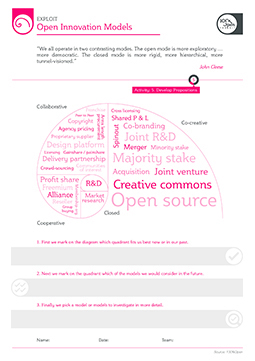Open Innovation Models
"We all operate in two contrasting modes.The open mode is more exploratory… more democratic.
The closed mode is more rigid, more hierarchical, more tunnel-visioned.”
John Cleese


Open Innovation Models are ways of defining the nature of a partnership. This tool is to help select the most appropriate basis for a new collaboration. It deals with ownership and what each partner will contribute to the new product or service. When we start looking for partners via a challenge it is important to advertise the Open Innovation Model we are offering. This strategy helps us find the right match faster.

First let’s familiarise ourselves with the range of open innovation models. On reflection we might be able to think of more examples from our general knowledge so let’s write those in. The four quadrants are defined like this:
Closed – in-house, secret R&D that generates IP for proprietary commercialisation.
Cooperative – cooperate to exchange IP or know-how for joint projects, temporary alliances or to access new markets.
Collaborative – collaborate in partnership, licence or combine IP, co-design or form a franchise.
Co-Creative – co-create IP, merge businesses, co-own new ideas or go open source.
1. First we mark on the diagram which quadrant fits us best now or in our past.
What are our current innovation models or what models have we used in the past?
2. Next we mark on the quadrant which of these models we would consider in the future.
How open do we want to be? What might be possible if we could make the case for stakeholders like the commercial or legal departments? Then mark those models that our competitors are using or firms that we admire from related sectors. Finally we ask ourselves the question ‘What would Google do in our market?’ and mark that on.
3. Finally we pick a model or models to investigate in more detail.
With all the previous analysis and research in mind, which Open Innovation Model are we going to choose? Why is this our choice? Is our organisation definitely going to be comfortable with the model we have chosen? If not it sometimes helps to specify two or three possible models. Here we can use the Give|Get tool to explore what the offer will be to potential partners under this business arrangement and what we expect to get in return.
Source: 100%Open
You must be logged in to download this tool
You must be logged in to download this worked example
2014 - 100%OPEN LTD